*Editor's Note: Norwegian classes have really kicked into gear, and most of my writing as of late has been done på norsk. This project will likely ramp up over the summer. I've also got namcompendium.com on lock and it redirects to a WordPress blog where these posts will be reblogged as an official repository.
At the outset of this project I stated quite clearly that I had no intention of considering the multitude of microcomputer ports of Namco games. This was admittedly an arbitrary decision based as much on my own desire to limit the scope of this project on at least one axis, as it was rooted in the circumstances of my own life; I am not from Europe, and am of an age that the multitudes of computing standards that existed before the PC stamped out all ecosystems are a curious footnote rather than a lived historical experience. For this entry, however, I am going to briefly pull the blinders off and consider the micros of years past. The reason is simply this: Bosconian (November 1981) is too good a game for me so cram into the same piece as Dig Dug, and its lack of 8-bit home console ports is more than made up for by it having appeared on a range of computers in its day.
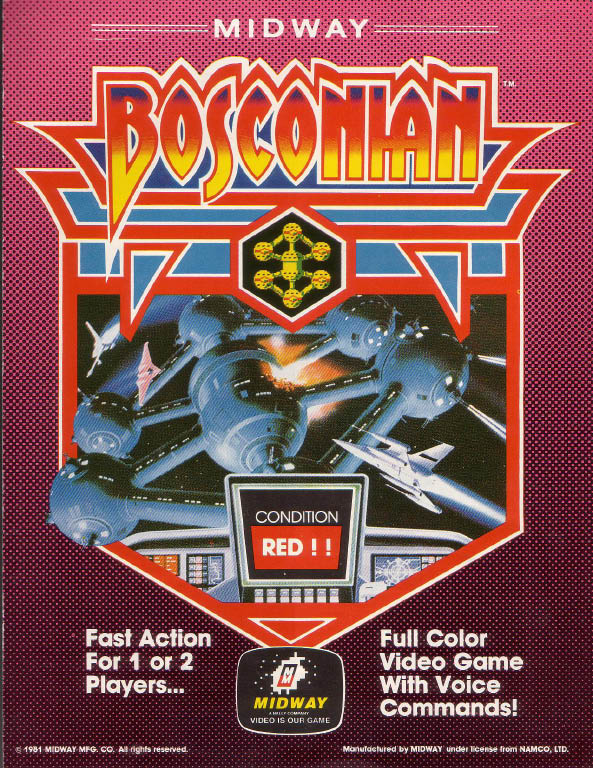
First off, Bosconian is a far better realization of any sort of primordial "open world" mechanics than the wet farts that were Rally-X and New Rally-X. The game could be summed up as Galaga with multidirectional scrolling, but I don't think that quite does it justice. Bosconian tasks the player with exploring sectors of hostile space, where green hexagonal bases and squadrons of enemy fighters are raising Cain. The player is placed into a sleek space craft that bares a certain resemblance to Yokoyama's prized craft from Galaga, but with one curious addition: it fires simultaneous from the front and the rear. It is a strange ability, but one that becomes immediately useful to the player.
Right from the gate, the game greets you with a brief but tasteful arcade jingle courtesy of Ohnogi Nobuyuki, whose work we have already explored. This is followed by hot NamCompendium Second: Bosconian is a talky that uses the same English lines delivered by a non-native speaker in all regions. There are five samples, up from the two featured in King & Balloon, and four of them ("Alert, alert!", "Battle stations!", "Spy ship sighted!" and "Condition red!") are context sensitive commands which not only add to the space fighter ambience, but also provide an aural stream of information to the player. This stream is invaluable, as the player also must contend with a busy playfield and a radar map in the bottom-right of the screen ala Rally-X. Said map displays the locations of space stations and the player, but not the locations of enemy formations and other cosmic debris. It does, however, give you a quick readout of the general security of the sector (using the standard green-to-red measurement of badness) and a sketch of the formation used by incoming small craft.
If it all sounds busy, you would be correct. But there's something to the harrying pace of this game that really makes it. In between accomplishing your primary goal of destroying enemy bases (which can be done by destroying their core or shooting six individual lobes for more points) the player must contend with ships from all directions, enemy fire, enemy crafts, mines, asteroids, reading a map, avoiding a spy ship, dodging missiles from the bases, lining up shots, and keeping cool while a man shouts out updates on how bad things are going. The game gives you tools to succeed in this environment: unlike Rally-X's horrible mazes, Bosconian is free scrolling and wraps around the playfield as you scroll to the edges of the map. The game also keeps the player's ship dead center of the screen at all times, which helps to mitigate any surprise bullshit deaths from the edge of the screen.
Alas, Bosconian was too beautiful for this world. The game received worldwide distribution, with Namco handling the arcade release in Japan and Midway receiving a license to distribute the game in North America. The cabinet is fairly difficult to find, however, and the main culprit is the runaway success of Galaga. As I understand it, hundreds of Bosconian cabinets were converted into Galaga machines, which made more money for operators and is admittedly a more readable and accessible game at a glance. It is a shame, as this is certainly one of the best games to be covered thus far in the NamCompendium.
I would wager its muted arcade performance, cannibalized by its more successful predecessor, had something to do with its lack of home console ports. But that's not really born out by the fact that Bosconian was kept in circulation across several microcomputer platforms throughout the 1980s. The first of these seems to have been developed in house by Namco and released for a platform so obscure our Wiki doesn't even have it as a platform: the Sord M5. Developed by Sord, the platform was released in Japan and the United Kingdom in 1982, and even managed to gain something of a foothold in Czechoslovakia as one of the first affordable computers available to hobbyists.
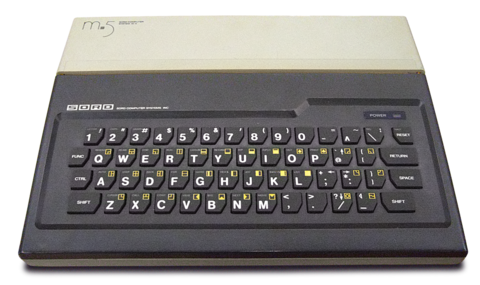
Exotic platform aside, what we have here is an 8-bit computer port of Bosconian that avails itself reasonably well upon release in 1982. All voice clips have been excised, but the opening jingle is recreated without being a disaster. Sprites and colors are altered here and there, and the way the M5 handled scrolling leads to some strange juttery objects on screen. Enemy routines are also trimmed down from the full fat arcade release. What's left, however, constitutes most of Bosconian. The stations are destructable pod by pod, the minimap works just as it did in arcades, and the pace of place is a reasonable facsimile of the true item. Not bat at all. Barring solid evidence to the contrary on the English Internet, it seems that Namco themselves handled this port and it shows.
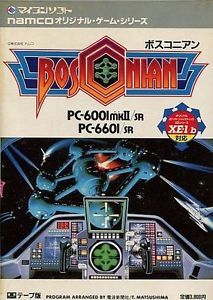
Next we come to Bosconian on the NEC PC-6001, the first home computer by the Nippon Electric Company. Specific information on this release is hard to come by in English. The title screen thankfully attributes the port to Dempa Shimbunsha, later Dempa Micomsoft, and "t.matusima". Some digging lead me to one Matsushima Tetsu, an individual who had a hand in this and at least one other home computer port of Bosconian. In retrospect, I am glad Dempa had another crack or two as this is not so great. We start very well, with a nearly-arcade perfect rendition of the opening jingle followed by the original muffled BLAST OFF! voice sample. Then the game starts. The sacrifice made to accommodate Bosconia on the 6001 was to constrict the view of the playfield to maybe a third of the total area seen in the arcade version. To account for the loss of visibility, the game runs slower than originally intended. Even with the minimap and surprisingly good sound here, this leads to a slower, less frantic, and less informed rendition of the game.
Things improved in 1984, when Namco internally developed and released Bosconian for the MSX. They managed to cram almost everything into this port. The opening jingle, a muffled BLAST OFF! sample, even reasonably smooth scrolling for an MSX title. The only real cut corners are some redrawn sprites (apparently the MSX color palette was small indeed) and the rest of the voice samples are gone as well. Otherwise, this is damn good stuff. Worth seeking out if you're into collecting for three decade old minicomputer platforms.
Bosconian next received four different home computer ports in 1987, one of which was done by the aforementioned Dempa for the Sharp X1. This port very much represents a "one step forward, two steps back" trade off. Dempa Micomsoft handled this version and things have improved over the PC-6001 release. We've got the opening jingle, but the BLAST OFF clip is badly muffled here. The playfield is much closer to the arcade original, but colors are not to spec and come off as quite garish. Almost Spectrum garish, in fact. The worst part of this version, which is likely down th the X1 platform itself, is the ratchet scrolling for on-screen objects. It creates a very jittery sensation during play, one absent from the older Namco-developed release on the MSX. This is merely functional, and the next time we see the Dempa name they will turn in something astounding.
The other three are genuine freaks of nature, the sort of thing that makes this project worthwhile. At some point in the mid-1980s, UK-based budget software label Mastertronic secured the rights from Namco to develop and publish minicomputer ports of Gaplus, Motos, and our dear sweet Bosconian. The former two were released under their original names, but Bosconian received a little extra attention in development. The end result is Bosconian '87, developed by Binary Design on behalf of Mastertronic, with license from Namco. This game is entirely separate entry in the Giant Bomb Wiki, and after doing some research I think this is a fine thing as Bosconian '87 is a fairly different game. To muddy the waters a bit further, there are noteable differences in each version.
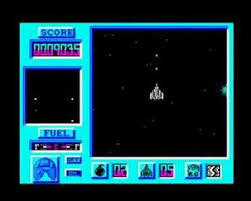
Let's start with the Sinclair ZX Spectrum. Not a particularly powerful machine, it nevertheless found the way into thousands of homes across the United Kingdom and, apparently, Spain. It also played home to a few very good arcade ports like R-Type. Bosconian '87 ain't no R-Type. The first thing you'll notice about Binary Design's conversion is just how small a view of the playfield you are given through the large and obtrusive HUD elements. The second and more concerning change is that your ship no longer begins with the ability to fire forewards and backwards from the start; this is instead relegated to an in-level power up. The player is given a supply of screen clearing bombs to handle surprise threats that rapidly enter from off screen while you hunt for this powerup, but this leads to the last major change here: you also have a fuel supply. Apparently Binary Design were big Jetman fans as fuel pickups also appear in the playfield, though like powerups these are not indicated on the in-game map. Couple these changes with a lack of audio cues around when enemy formations enter the playfield (indeed, no voice clips made the jump here) and the game winds up feeling very different. Bosconian empowers the player and provides them with a lot of tools and streams of information to solve the problems at ahand; Bosconian '87 places additional constraints on the player and pairs back those tools, and leaves you feeling much more vulnerable as a result.
Now, take everything I said in the above section, add a little more bass to the tasteless chiptune music and a blue filter, and you have the Amstrad CPC version. You'd think music during play would be a plus, but honestly I'd prefer the PC speaker-esque sound of the Speccy version over this. Eek.
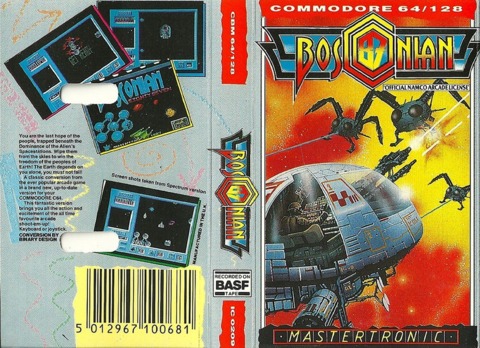
And then, we hit rock bottom with one of the worst things I have played in a very long time: Bosconian '87 on the Commodore 64. Holy shit fam, it's hard to know where to start when you are presented with something this unpleasant. Binary Design's work on the C64 apparently has something of a reputation for being proper kusoge, and if this is any indicator they earned their shit stripes. It starts so innocently, even promisingly, by providing the player with a nice big view of the playfield. The entire HUD has been reduced to a horizontal bar tha takes up maybe a third of the screen real estate. This has two major consequences: the map is now incredibly small, and the playfield is constricted on its vertical axes. Then you begin play and things fall into pieces. It would have been bad enough if they had only failed to put the enemy bases onto the map, which turns the game into an actual blind hunt for objectives. But the real issue here, counterintutively, is that the game is just too damn fast. You move at least twice as fast as the arcade original, perhaps more. Couple that with little indication of what is coming at you from two directions, lack of awareness of base locations, inability to fire backwards without a powerup, and the same dreaded fuel gauge management, and you get an absolute debasement of a masterful game. Abominably, unbelievably bad.
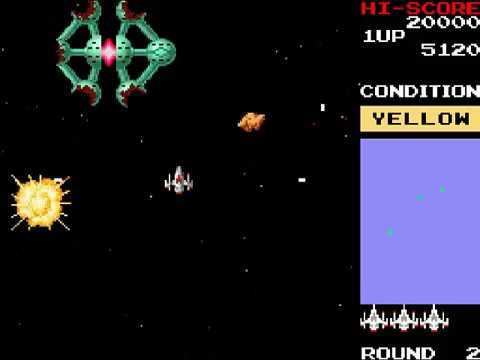
Something as soul shaking as Bosconian '87 on the C64 warrants a palette cleanser, and thankfully we end this foray into computer ports on an incredibly high note. In December 1988, Dempa Shimbunsha had one last go at porting Bosconian. This time the platform of choice was the Sharp X68000, a Japan-exclusive computer built around the venerable Motorola 68000 CPU. In addition to the Matsushima Tetsu's name cropping up in the credits again, there's another familiar name tied to this port: Yuzo by god Koshiro himself graced this port with music. Koshiro improves almost everything in life, and this was no exception. Rather than attempting to recreate the arcade opening jingle, the game instead receives something like an opening cutscene complete with outrageous but appropriate FM synth music. You are then treated to easily the best version of Bosconian on any platform. The sprites have been gently redrawn and while edges are bit soft, the overall impression is a deliberate aesthetic choice rather than a lazy redrawing of assets. The pace of play is also slightly increased, and transitions between levels is also more rapid. There are even a few modes of powering up your guns in later levels, made available either by the top menu or with a handy level skip code. The arcade original absolutely holds up, but this is nothing short of an "arrangement" version of Bosconian and comes with my highest recommendation. The soundtrack alone is worth a listen, and thankfully somebody has already done God's work on YouTube.
After those lofty heights, Bosconian faded into Namco's back catalog for seven years. Clearly the company saw something in the game, however, as it was one of the first seven titles to be compiled under the unending Namco Museum efforts to leverage their legacy games for money. Bosconian sat right along side Pac-Man and Galaga (alongside ne'erdowells like the Rally-X games) on Namco Museum Volume 1. It next resurfaced after a decade on Namco Museum 50th Anniversary Collection (XBOX, PS2, GCN; 2005), followed by Namco Museum Battle Collection (PSP, 2005), then again on Namco Museum Volume 2 (PSP, 2006; JP). Things then begin to space themselves out, like the increasingly distant signals from the Voyager satellites. It found a spot on Namco Museum: Virtual Arcade (360, 2008), the Japanese Wii Virtual Arcade (2009), and the North American exclusive Namco Museum Megamix (2010). It is playable on the PS3 and Vita through the presence of NaMuVo1 on PSN, making the Vita its most recent port of call on a sort of technicality. Bosconian was not included in last year's Namco Museum '17 release for the Switch.
Barring the discovery of another barnburner such as Bosconian, I have no intention of doing as deep a dive into home computer ports again. Bosconian deserves as much love as I can give it, and anybody with any inkling of respect for arcade games of its era would be well served to track it down. The original format is great right out of the box, but for something a little extra I'd recommend giving the X68000 port a whirl. It's everything the arcade game is, plus Yuzo Koshiro doing what he does best.
Next time around, we're back to familiar stomping grounds: strange Famicom/NES release schedules, in-house Atari ports, all that good stuff. Dig Dug is next on the NamCompendium block, and I look forward to finding more horror stories.
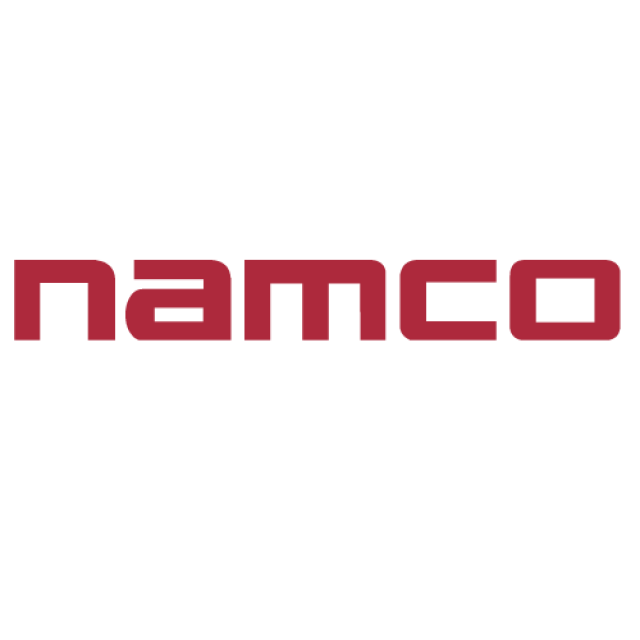
Log in to comment